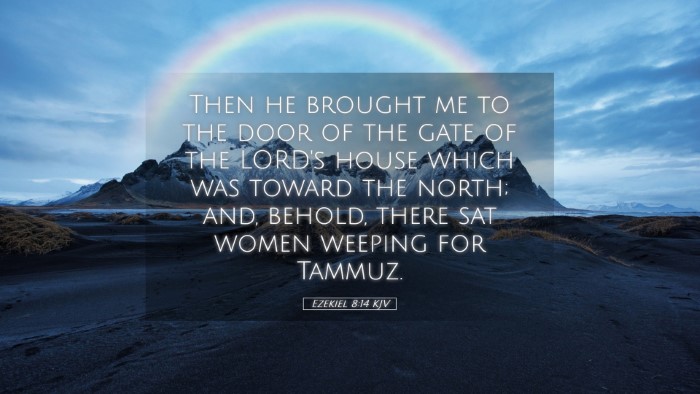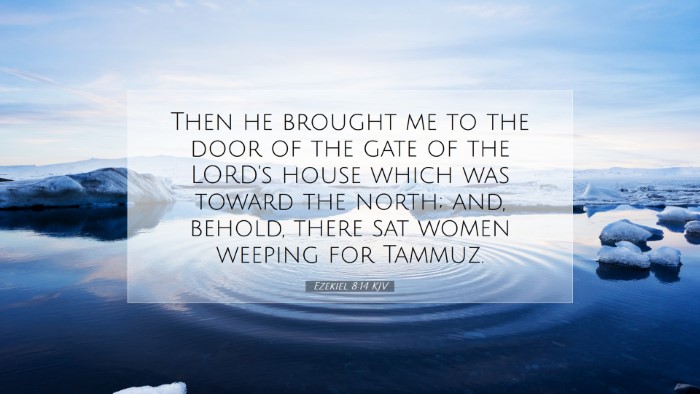Ezekiel 8:14 - Commentary Overview
Ezekiel 8:14 states: "Then he brought me to the entrance of the gate of the LORD's house, which was toward the north; and, behold, there sat women weeping for Tammuz."
This verse unfolds a significant moment in Ezekiel's prophetic vision, revealing the spiritual state of Israel during a time of deep idolatry and moral decay. The imagery presented in this passage is rich in symbolism and historical context, necessitating a thorough exploration of its implications and meanings for contemporary believers and scholars alike.
Contextual Background
The book of Ezekiel addresses the exile of Judah and the profound consequences of their actions against God. Ezekiel, called as a prophet, is tasked with both condemning the idolatry prevalent among the people and providing hope for restoration. In chapters 8-11, he experiences a vivid vision where the Lord shows him the abominations occurring in Jerusalem.
Commentary Insights
Matthew Henry - Spiritual Corruption and Idolatry
Matthew Henry emphasizes the stark contrast between the holiness of God and the gross idolatry practiced by His people. In this verse, the act of women weeping for Tammuz signals a departure from true worship and a gravitation towards pagan rituals. Tammuz was a deity associated with fertility, whose cycle of death and rebirth reflected the agricultural seasons. The weeping portrays deep emotional investment in a false god, illustrating how the Israelites' hearts had turned away from Yahweh.
Albert Barnes - Weeping for Tammuz as a Symbol
Albert Barnes expands on the symbolism of Tammuz, noting that this lamentation for a false god represented a desperate yearning for life and regeneration, which they sought outside of God. He points out that the worship of Tammuz involved mourning rituals and fertility rites, often linked to the agricultural cycles, signifying a reliance on human efforts rather than divine provision. Barnes argues that this behavior shows a profound spiritual decline, as the people abandoned their covenant relationship with God in favor of hollow traditions.
Adam Clarke - The Deception of Idolatry
Adam Clarke provides a detailed analysis of the historical context surrounding the worship of Tammuz. He notes the cultural influences from neighboring nations and the syncretism that occurred within Israelite practices. Clarke asserts that the weeping women symbolize not merely individual apostasy but a collective societal failure to recognize the true nature of God. The passage underscores the peril of integrating pagan practices into the worship of Yahweh, demonstrating how this compromise leads to spiritual blindness and divine judgment.
Theological Implications
The act of weeping for Tammuz in Ezekiel 8:14 reveals critical theological themes that resonate across time. This episode illustrates the struggle between faithfulness to God and the allure of cultural practices that pull believers toward idolatry. Pastors and theologians can draw parallels to the contemporary Christian experience, where distractions and secular ideologies often entice the faithful away from biblical truths.
Idolatry in Modern Times
The idolatry referenced in Ezekiel's vision may not take the same form today, yet its essence remains. Modern "Tammuz" could be anything that believers prioritize over their relationship with God—materialism, fame, or personal ambition. Reflecting on this passage compels believers to evaluate their priorities and consider how contemporary practices can echo the same misplaced devotion seen in ancient Israel.
The Call to Repentance
The mercy of God, even amidst judgment, is a recurring theme in Ezekiel. This scripture points to the need for repentance and a return to authentic worship. As pastors preach on this subject, they should emphasize the availability of grace and restoration for those willing to turn back to God, highlighting that the depth of sin and idolatry never exceeds the reach of God's mercy.
Practical Applications
In light of Ezekiel 8:14, several lessons emerge for personal and communal reflection:
- Self-Examination: Believers should regularly assess their lives for signs of idolatry or misplaced affections, ensuring that their devotion is anchored in Christ alone.
- Community Accountability: Churches must foster environments where congregants can confess struggles with idolatry and seek accountability in their spiritual journeys.
- Education on Worship: Pastors should teach about the nature of true worship, helping the flock distinguish between genuine faith and cultural practices that conflict with biblical teachings.
- Encouraging Repentance: Leaders should encourage a culture of repentance that acknowledges failures, seeks forgiveness, and embraces the transformative power of God’s grace.
Conclusion
In Ezekiel 8:14, the weeping for Tammuz encapsulates the profound spiritual crisis facing Israel at the time. Through the insights gleaned from the commentaries of Matthew Henry, Albert Barnes, and Adam Clarke, we see the rich layers of meaning these verses offer for both ancient Israel and modern believers.
As we examine this verse, may we be urged to avoid the pitfalls of idolatry and remain steadfast in our devotion to the one true God, recognizing that true life and fulfillment are found solely in Him.


